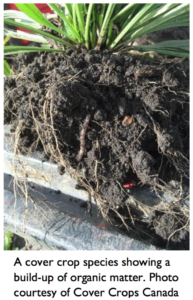Cover Crops

Cover crops are typically diverse, annual crop mixtures planted with the intent to build and improve the soil. Cover crops may also include biennial or perennial species, depending on the end-use and goals of the producer. Cover crops may be grazed, baled, or used for silage, depending on the species that are seeded. Cover crops may also be used as a green manure or plough-down crop.
Cover crops, often called “cocktails,” consist of plants that will benefit the soil ecosystem and support a variety of soil microbes, fungi, and other biodiversity, such as earth worms. Cover crops can enable soils to have improved water infiltration, increased organic matter, and more efficient nutrient recycling. Some cocktail crop species may be useful in utilizing excess water in a field that would otherwise be water logged, while other species may be selected for their drought-tolerant qualities and their ability to make the most efficient use of existing moisture.
Click here to subscribe to the BCRC Blog and receive email notifications when new content is posted.
The sharing or reprinting of BCRC Blog articles is welcome and encouraged. Please provide acknowledgement to the Beef Cattle Research Council, list the website address, www.BeefResearch.ca, and let us know you chose to share the article by emailing us at info@beefresearch.ca.
We welcome your questions, comments and suggestions. Contact us directly or generate public discussion by posting your thoughts below.